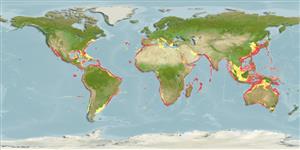Preferred temperature (Ref.
115969): 8.7 - 18.6, mean 12.6 (based on 736 cells).
Phylogenetic diversity index (Ref.
82804): PD
50 = 0.5000 [Uniqueness, from 0.5 = low to 2.0 = high].
Bayesian length-weight: a=0.00759 (0.00428 - 0.01346), b=3.08 (2.93 - 3.23), in cm Total Length, based on LWR estimates for this species & Genus-body shape (Ref.
93245).
Mức dinh dưỡng (Ref.
69278): 4.3 ±0.2 se; based on diet studies.
Thích nghi nhanh (Ref.
120179): Rất thấp, thời gian nhân đôi của chủng quần tối thiểu là hơn 14 năm (rm=0.02; also Musick et al. 2000 (Ref.
36717)).
Prior r = 0.09, 95% CL = 0.06 - 0.13, Based on 1 data-limited stock assessment.
Fishing Vulnerability (Ref.
59153): Very high vulnerability (88 of 100).
Climate Vulnerability (Ref.
125649): High vulnerability (62 of 100).
